PROJECTS
Project overveiw
Great Eastern Gold (GEG) is a producing gold mining company with operations in Australia and South America.
In Ecuador, GEG is already generating gold through its fully permitted Cominzaza (Guayzimi Alto) mine in the south of the country. The operation is producing today, supported by an on-site CIP processing plant with an expansion pathway to lift throughput. The broader skarn belt offers multiple open-pit and underground growth opportunities, giving GEG both immediate cash flow and long-term scalability.
In Australia, GEG is advancing four near-production gold mines in Northern Queensland: Welcome Again, Big Rush, Camel Creek, and Golden Cup. Each mine sits on granted Mining Leases and is supported by a JORC-compliant resource base of 487,000 ounces of gold. These assets are undergoing staged development toward a combined production target of 140,000 ounces per annum by Year 2.
Three of these mines, Big Rush, Camel Creek, and Golden Cup, host substantial heap leach ore stockpiles from historical mining in the 1990s. These pads are ready for immediate processing, with recent sampling and RC drilling confirming continuity and metallurgical viability. This provides a pathway to rapid gold production while larger-scale mining ramps up.
The Welcome Again Mine, near Charters Towers, holds a JORC-compliant 102,000 oz resource and is fully permitted. Production will commence following installation of a modular processing plant and underground shaft infrastructure, with first gold pours targeted by mid-2026.
Beyond near-term production, GEG holds an extensive exploration pipeline:
-
In Queensland, the Golden Ant Portfolio spans over 700 km² with more than 52 historic mines, hosting significant unmined gold potential.
-
In Western Australia, fully permitted mining leases in Kalgoorlie/Menzies are under exploration to grow the longer-term production pipeline.
GEG’s strategy—anchored by current production in Ecuador and staged development in Australia—mitigates single-asset risk and positions the company for scalable, multi-jurisdictional growth.
Cominzaza – Ecuador
Status: Producing Gold • Plant: on-site 700 tpd CIP (fully permitted) Production potential: ~58 koz Au/yr • Inventory Resource: ~465 koz Au defined in top 200 m.
Production & Revenue Potential: The mine is currently producing via artisanal operations (~50 tpd), with doré typically ~92% Au / 8% Ag. With the restart of the on-site, fully permitted industrial plant (550 tpd, expandable to 700 tpd), the project targets ~8 g/t head grade at ~95% recovery for ~58,000 oz Au per year. Defined inventory totals ~465 koz Au in the upper 200 m, and remaining open-pit resources across skarn bodies exceed ~397 koz Au, supporting a robust multi-year plan.
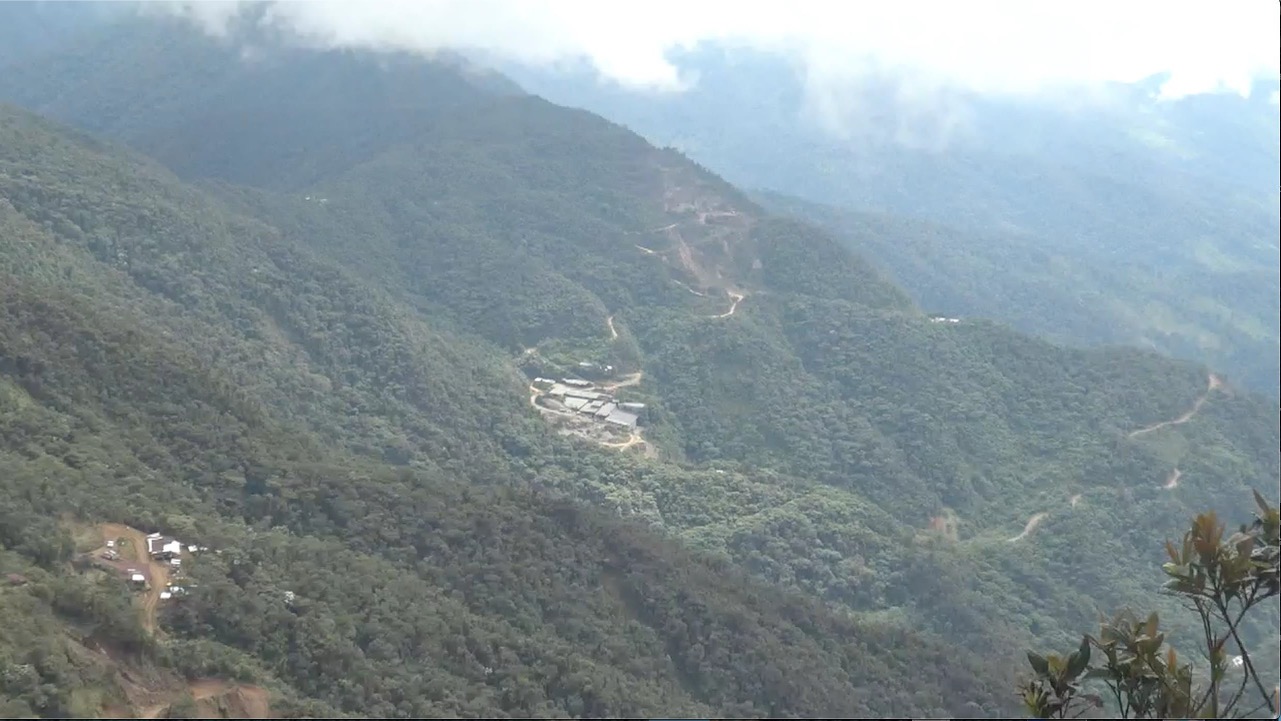
Drilling Upside: A total of 6,893.5 m in 56 drillholes underpins the current model, yet mineralisation remains open along strike and at depth. Field evidence indicates ~500 m of additional mineralised extent below the drilled horizon, supporting an exploration target up to ~5 Moz Au. Parallel skarn bodies adjacent to the Central pit provide immediate brownfields growth.
Processing & Infrastructure: The site hosts a crushing + CIP plant (550 tpd) with gold room, lab, and electrolysis circuit; the plant is fully permitted and ready for restart/expansion to 700 tpd. Historical artisanal processing since 2014 has left recoverable value (e.g., measured losses in concentrate/flotation/tails), creating upside for modern circuits. Power is supplied by diesel (scaling to ~2 MW) with a nearby 440 kW grid tie planned; Eurogen river turbines on the Nangaritza are proposed to reduce opex and, longer-term, target scalable generation for future expansion.
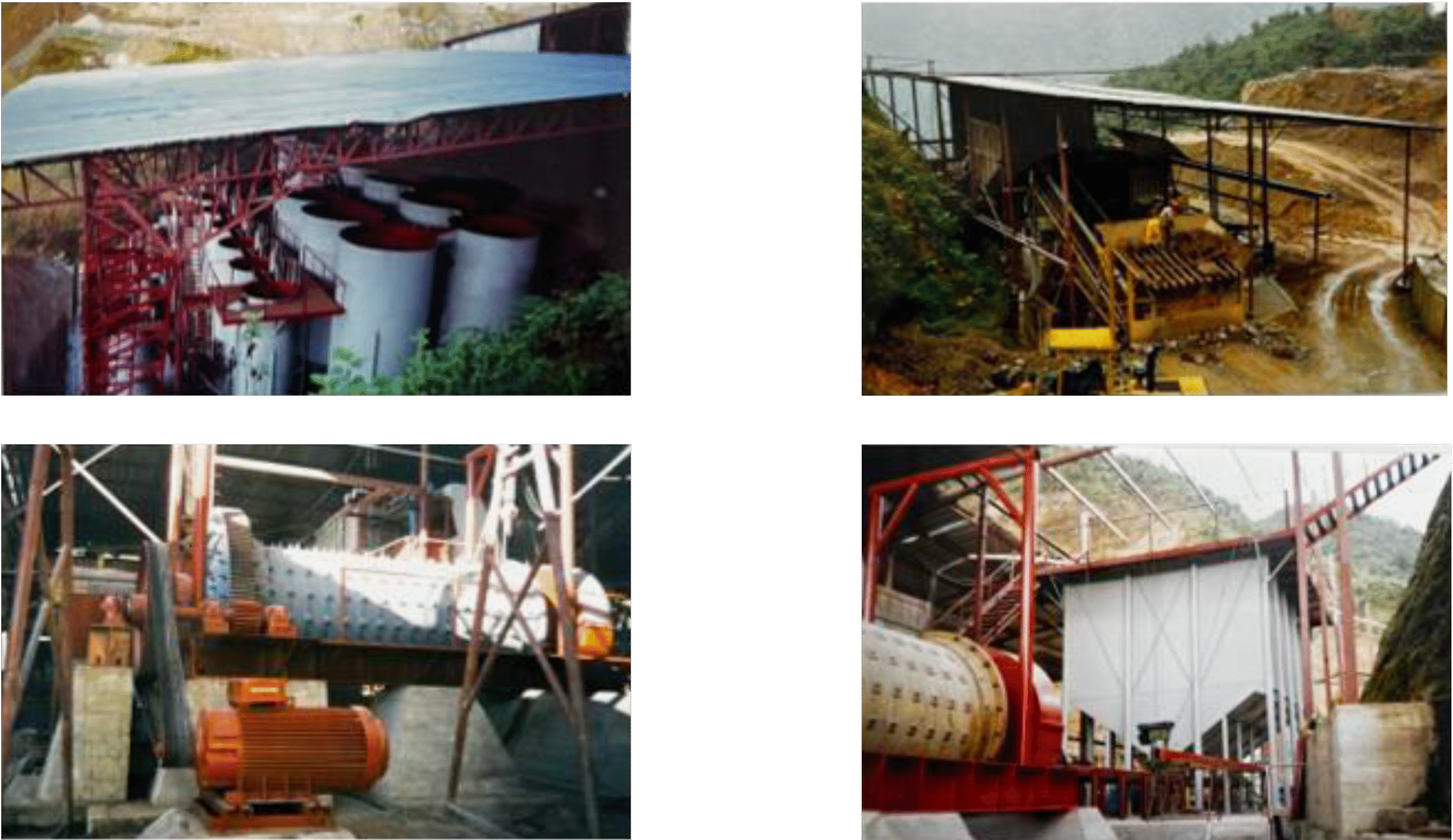

Welcome Again
The Welcome Again Mine, located 25 km south of Charters Towers, is one of Great Eastern Gold’s flagship near-production assets . The project is fully permitted and sits on a granted Mining Lease, ready for underground development.
Production Potential & Revenue Generation: The Welcome Again Mine has a JORC-compliant resource of 102,000 oz, with strong upside potential from recent modelling. Initial development will be driven by long-hole open stoping methods, supported by a newly constructed shaft and modular gold processing infrastructure. With a targeted production start in July 2026, the project is positioned for a rapid ramp-up and robust early-stage cash flow generation from high-grade ore.
Strategic Location: Situated within a historically rich goldfield, just 4 km from the Mount Leyshon Mine, Welcome Again is surrounded by proven geology and established mining infrastructure.
Big Rush
Big Rush is a near-production asset positioned to become a key early revenue generator for Great Eastern Gold. Located in Northern Queensland and fully permitted, the mine benefits from existing infrastructure and a historically proven gold system.
Production & Revenue Potential: Gold production at Big Rush is forecast to commence in 2025, starting with the immediate reprocessing of ~950,000 tonnes of oxide ore from historical heap leach pads. The project hosts a JORC-compliant resource of 157,000 ounces, distributed across multiple defined pit areas including Central, Northern, Southern, and Sergei. A staged development strategy will target shallow open-pit oxide and transition ores in the early phases, with plans to advance into underground mining of high-grade sulphide zones as the project matures.

Drilling Upside: Recent infill and extensional drilling has confirmed continuity and depth extensions of the mineralised system, significantly enhancing confidence in the current resource. These results strongly support the potential upgrade of the JORC resource, increasing both life-of-mine and project valuation.
Processing & Infrastructure: A new, on-site modular plant with gravity separation and in-line leach reactor will deliver high recovery rates from both oxide and refractory ore. Initial production from reprocessed heaps ensures immediate cash flow while the open pits and deeper underground zones are developed.

Camel Creek
The Camel Creek Mine, located within the Amanda Bell Goldfield, is a large-scale, high-upside project with both near-term production and long-term growth potential. It hosts a JORC-compliant resource of 202,000 oz of gold across oxide and sulphide domains, with significant additional value from an estimated 9,000 tonnes of antimony.
Production & Revenue Potential: Initial production at Camel Creek is set to begin in 2025 with the reprocessing of ~1.2 million tonnes of historical heap leach ore, delivering immediate, low-cost gold recovery. The project will follow a multi-phase development plan, starting with open-pit mining of shallow oxide zones, then transitioning to underground mining to access deeper, high-grade sulphide ore bodies. Notably, the Hinge Zone, a significant sulphide-rich structure, remains entirely unmined and represents a high-margin future feedstock with strong economic potential.

Drilling & Expansion Upside: A 2020 RC drilling campaign (18 holes, 2,516m) confirmed continuous gold mineralisation over a 2.5 km strike, with every hole returning gold intercepts. High-grade intersections such as 24m @ 3.55 g/t Au and 9m @ 4.99 g/t Au support a near-term JORC upgrade and validate the potential for a significant underground resource.
Strategic Processing Infrastructure: Ore will be processed onsite using gravity concentration and an In-Line Leach Reactor, ensuring strong gold recoveries from both oxide and refractory ores. In addition, the presence of antimony-bearing minerals such as stibnite allows for concurrent recovery of antimony through flotation, providing a valuable secondary revenue stream.

Golden Cup
The Golden Cup Mine, located in the Amanda Bell Goldfield in Northern Queensland, is a high-grade, near-term gold producer with significant upside. It hosts a JORC-compliant inferred resource of 256,000 tonnes @ 3.6 g/t Au (approximately 30,000 ounces) and is permitted on a Mining Lease.
Production & Revenue Potential: Production at Golden Cup will commence with the reprocessing of approximately 300,000 tonnes of ore stockpiled on historical heap leach pads, allowing for rapid, low-cost gold recovery and immediate cash flow generation. The ore will be transported to the nearby Camel Creek modular processing plant, significantly reducing capital expenditure by utilising existing shared infrastructure.
Exploration & Resource Upside: A recent RC drilling campaign (11 holes, 1,022m) confirmed high-grade gold extensions beneath historical pits. Notable intercepts include 7.0m @ 4.6 g/t Au, including 2.0m @ 14.3 g/t Au in hole GCRC093, and 6.0m @ 7.4 g/t Au, including 3.0m @ 11.3 g/t Au in hole GCRC094.
These results demonstrate continuity of mineralisation at depth and validate the potential to significantly increase the existing JORC resource through a planned follow-up drilling program in 2025.

The Grafter West Mine
The Grafter West Mine is located on the Puddler Creek formation adjacent to the Welcome Again Mine. It was mined to a shallow depth at around the same time the Welcome Mine and the Great Eastern Mine were operating. It has the same quartz-carbonate-sulphide veins as the Welcome Again, containing free coarse grained gold and gold associated with pyrites.
Drilling and sampling at the Grafter West showed some promising assays, showing 11.9 and 12 grams per tonne in separate drill holes with costean samples of 9.7 and 3.3 grams per tonne. A larger drilling program is planned to ascertain the extent of the ore body and assist in establishing a best-practice mining plan for its extraction.
When the addition exploration is completed, mining will commence. Until then, the Grafter West site will be used as stockpile and storage for operations on the Welcome Again or Great Eastern Mines.
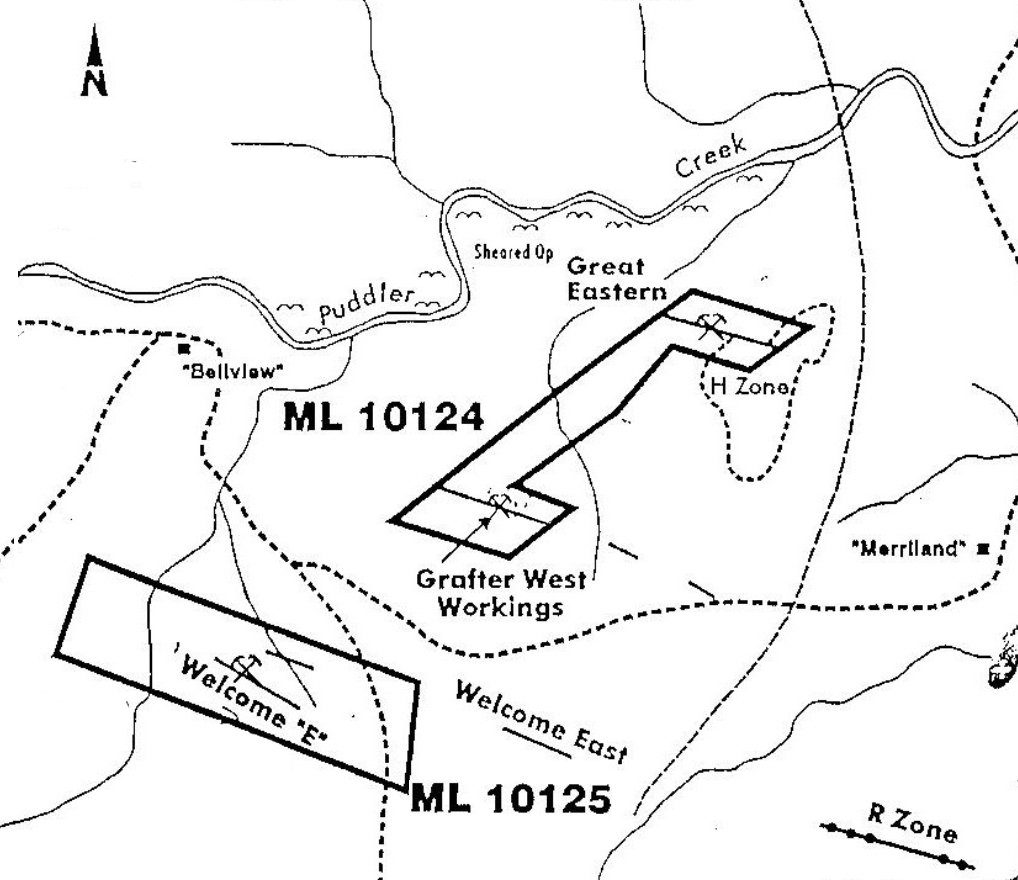
The Great Eastern Mine
The Great Eastern Mine consists of historical workings on the Puddler Creek formation. The geology at The Great Eastern corresponds with The Welcome Again and The Grafter West Mines. A small drilling program was exercised at The Great Eastern Site and some promising intersections were made.
The Great Eastern Mine is on ML10124 produced 254 ounces of gold from 163 tonnes of ore between 1901 and 1906. The workings extended to 43 m deep, over a strike length of 200 m. Grades of battery returns reported for the mine are better than one ounce to the tonne.
The geology and mineralisation of this mine is similar in nature to the Welcome Again Mine. Based on drill results, Great Eastern Gold has identified an exploration target to a depth of 200 metres although like other mines in the Charters Towers region, the resource may run to depths of 1000 metres or more and the resource may well be substantial or equal to the Welcome Mine.
Great Eastern Gold plans to conduct further drilling to delineate the resource as this project will be a natural follow-on progression for mining after ML 10125.
Great Eastern Mine Exploration Target |
||
|---|---|---|
| Tonnage Range | Au Grade Range | Au oz Range |
| 100,000 – 135,000 | 4.0 – 10.0 g/t | 13,000 – 43,000 |
Gold Head
The Gold Head goldfield, located in the Mcllwraith Range on the Cape York Peninsular, is situated some 48 kilometres northeast of Coen and about 460 kilometres northwest of Cairns. Alluvial gold was worked in the region in the early 1900s. Renaissance rock chip sampling has been done with promising assay results, including a sample of 85.5 g/t.
The Gold Head mineralisation consists of mesothermal quartz + calcite + chlorite + pyrite + arsenopyrite fissure veins within the Kintore Ademellite. At the northern end of the system, a single vein plus several major splays have been identified. Four zones containing elevated gold concentrations have been identified, which may potentially provide a basis for mining.
Great Eastern Gold has an Exploration Permit covering 29 subblocks over 87 square kilometres and may embark on a drilling programme to delineate the resource.
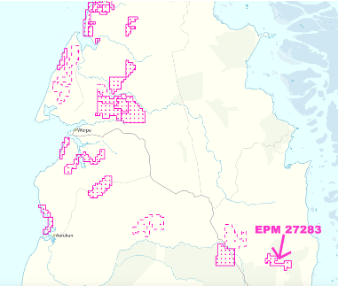
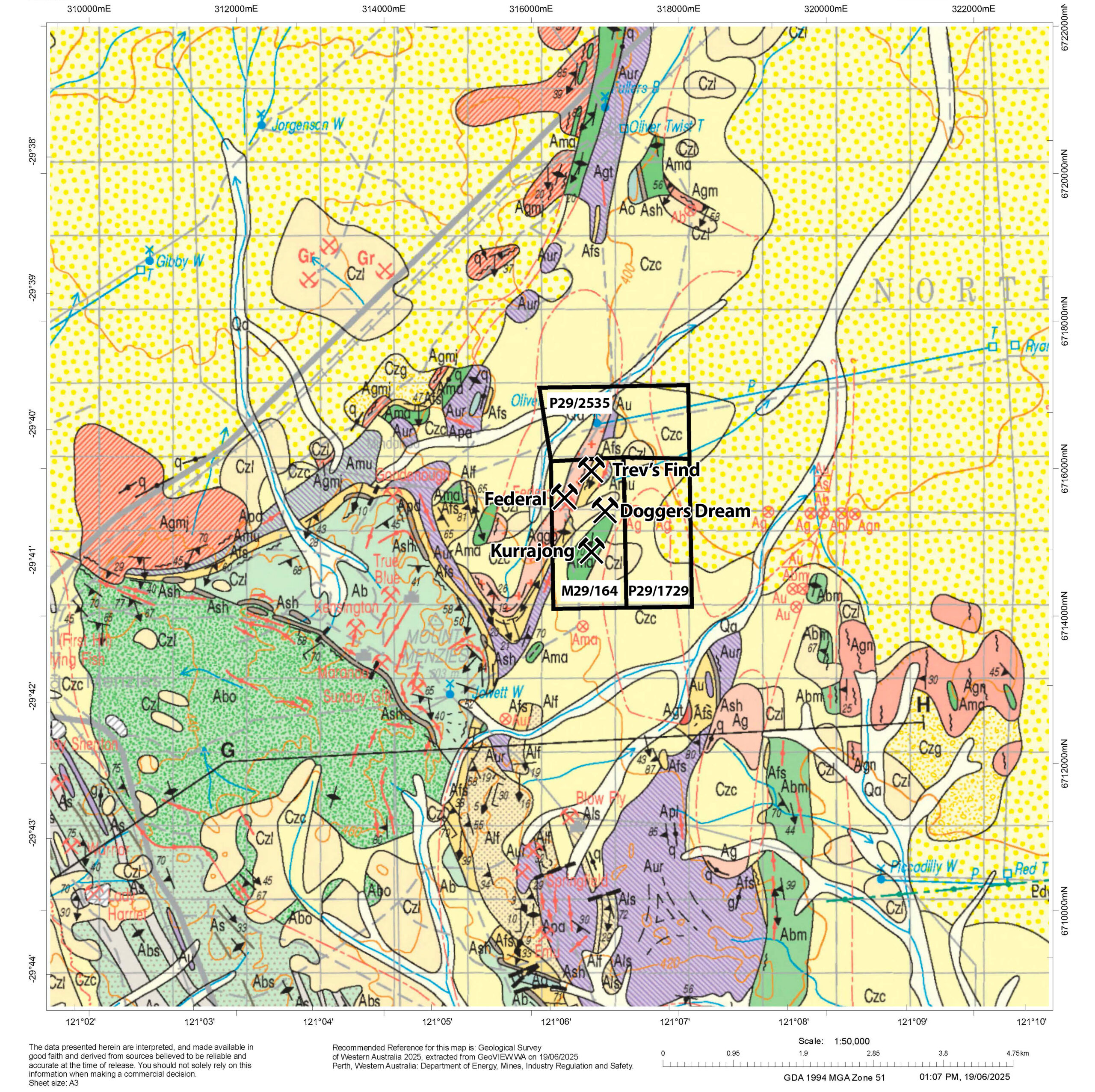
Menzies
Comprised of a mining licence M29/164 and adjoining prospecting licences P29/2365 and P29/2535, each approximately 200Ha in size near Kalgoorlie, Western Australia.
Consists of four historic gold mines – Federal, Trev’s Find, Kurrajong and Dogger’s Dream.
Since 2012, 10kg of gold has been recovered from prospecting on site.
Federal, Trev’s Find and Kurrajong all have historical workings dating back to 1902, each of which yielded around one ounce to the tonne.
A 20km continuous strike of a mineralised Greenstone Belt runs through the region, including the Springfield Venn Gold Corridor, the Goodenough Syncline, and the Moriarty shear zone.
Limited rock and chip sampling are highly promising, and processed gold from a test parcel of 40 tonnes yielded approximately 5g to the tonne.
A drill programme is planned for Dogger’s Dream site.
Yerilla
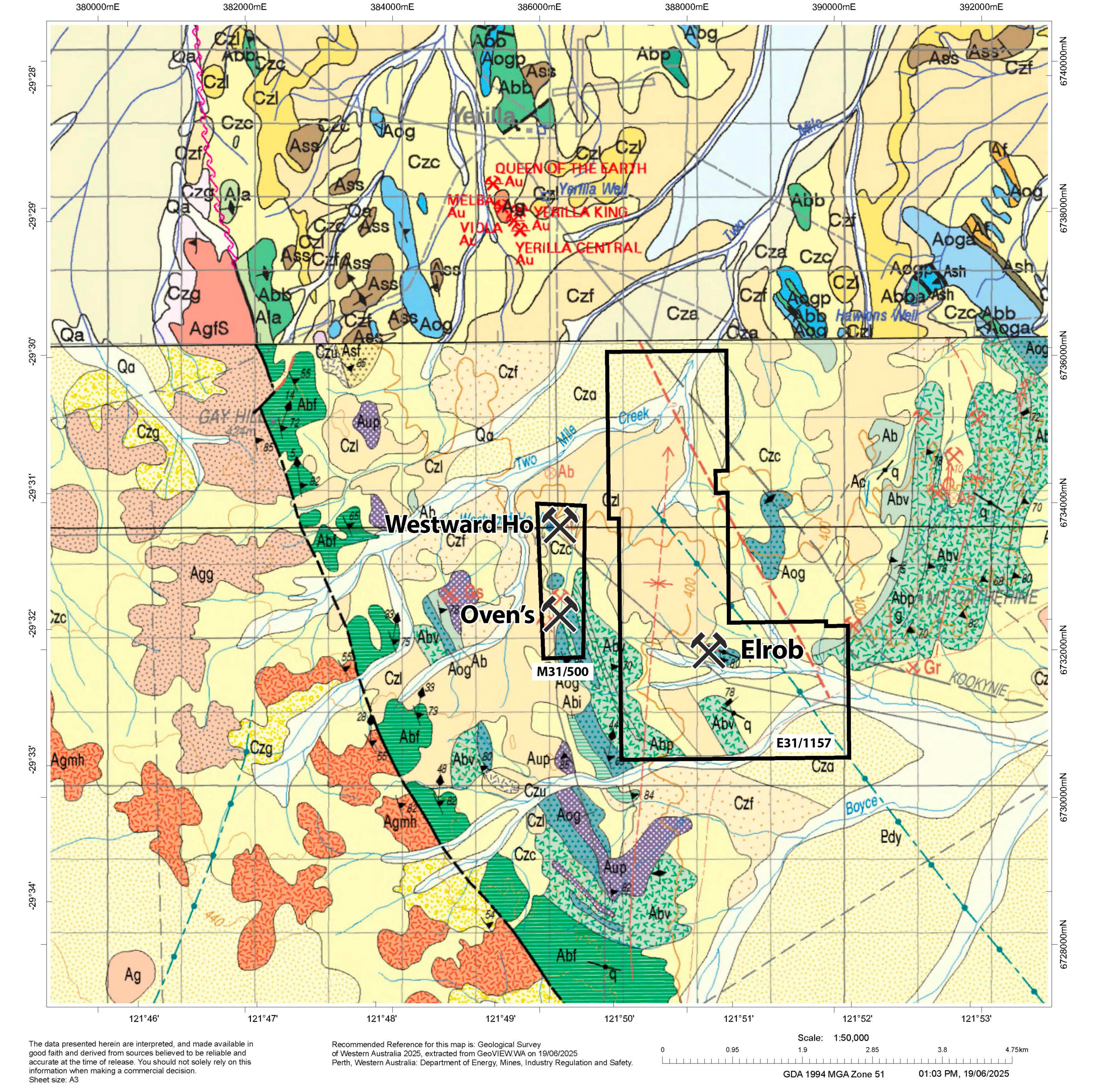
Westward Ho
Great Eastern Gold’s Yerilla district in Western Australia hosts three highly prospective gold mines, with Westward Ho standing out as the most advanced and promising. This historic mine features a shallow oxide zone ideal for open-cut mining, supported by strong exploration results including a 40m deep shaft, rock chips grading up to 7.32 g/t Au, and a historic drill intercept of 20m @ 1.34 g/t Au.
Oven’s & Elrob
Oven’s Mine presents a compelling opportunity for small-scale, low-cost production. Historic artisanal workings and recent rock chip sampling have confirmed gold-bearing quartz veining within altered shear zones.
Elrob Mine is in an earlier exploration phase but has shown signs of significant coarse gold potential. Historical alluvial gold recovery across the tenement, including nuggets up to 6 oz, highlights the area’s prospectivity. Recent auger sampling has identified widespread low-grade gold anomalism, supporting the potential for a larger subsurface system.
